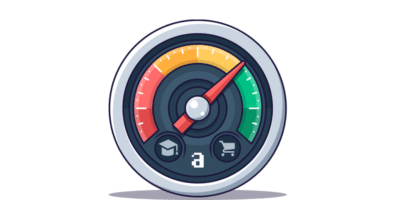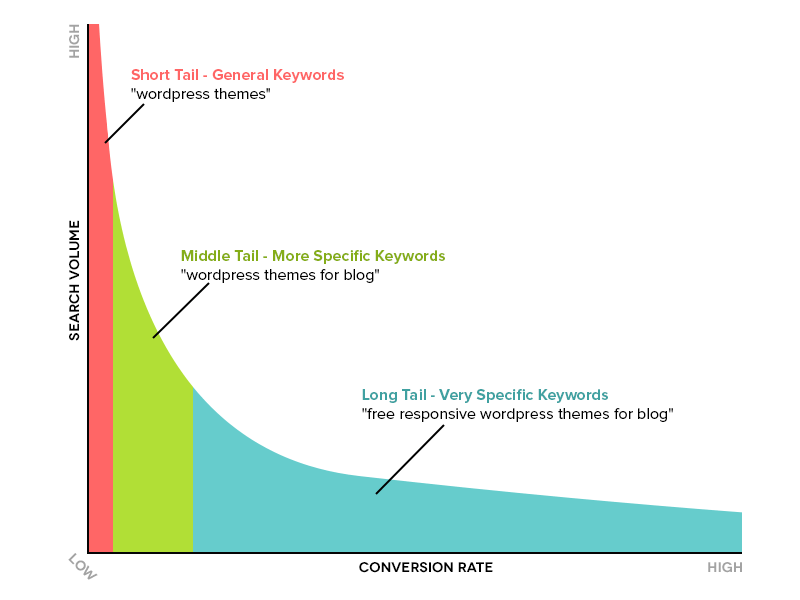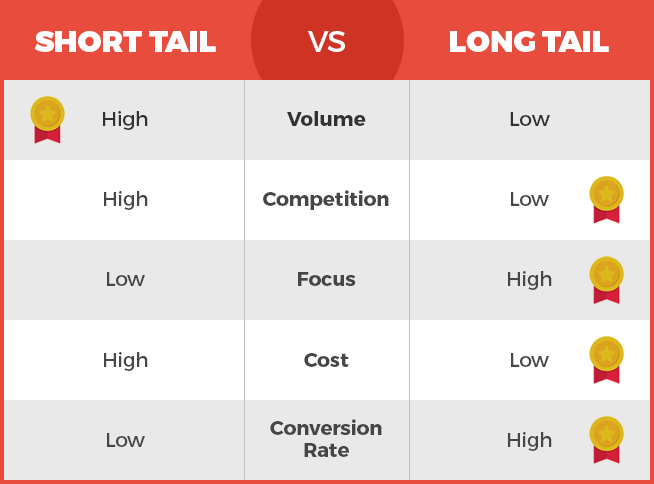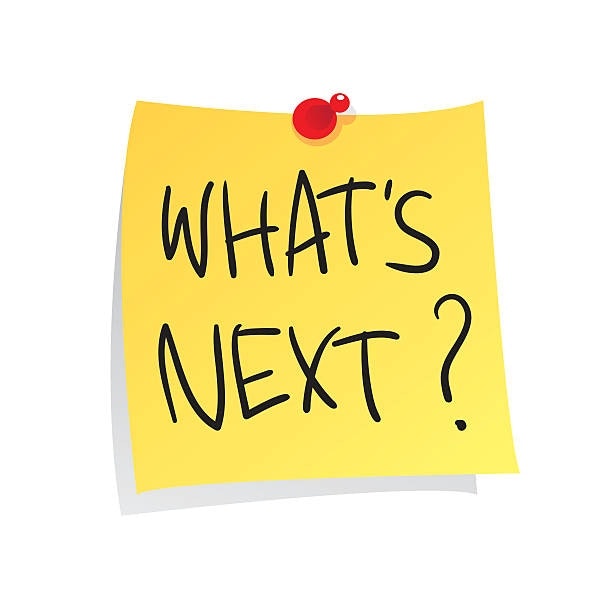






Effective keywords
Having lots of keywords will improve your SEO and SEA, but having a high quality set of keywords is just as important.
So what makes a set of keywords high quality and effective?
To understand that, you need to understand:
the types of keywords that exist,
the varying degree of buying intent of keywords, and
the importance of having keywords that include several words (i.e. long-tail keywords).

Types of keyword intent
When someone conducts a search via a search engine like Google, they have a particular reason for their search, i.e. they have a particular intention.
These search queries and their corresponding keywords can be put in four categories based on intent.
Navigational searches are performed to find a specific website or page.
If someone types “netflix” into Google, that’s a navigational search because they’re almost certainly looking for Netflix’s homepage.
Informational searches are performed to answer a specific question or find general information. If someone types "Vienna weather" into Google, that's an informational search because they want to find information the weather in Vienna.
Commercial searches are performed to learn more about brands, products or services. If someone types "Samsung s20 reviews" into Google, that's a commercial search since they are investigating the Samsung S20 phone.
Transactional searches are performed with the intention of making a purchase or transaction. If someone types "buy hiking shoes online" into Google, that a transactional search since they want to buy hiking shoes.

Buying intent of keywords
With these keywords types in mind, we can also categorize keywords based on their buying intent.
High-intent keywords are those that match searches that have a high likelihood of converting into a sale.
Commercial and transactional searches are usually high-intent, since they are made to find information about a product or make a purchase.
Low-intent keywords are used to make searches that have a low likelihood of conversion.
Informational searches are usually low-intent, since they are made to find specific information that doesn't relate to a commercial need.
Navigational searches can be low- or high-intent depending on the nature of the search. When they involve finding a website that has no commercial purpose, they have a low buying intent. However, when they are made to find a specific brand or an online shop, then they have a high buying intent.

Keyword length
Keywords can also be categorized based on the number of words used in the keyword.
Short-tail keywords include only one or two words, while long-tail keywords include three or more words. Of course, putting them into these two categories is a simplification and in general you can consider the overall length of a keyword from low to high.
Short-tail keywords tend to:
Be more general in nature, since they only include one or two words. For example, “shoes” or “running shoes” are short-tail keywords and, as you can tell, aren’t very focused.
Have a high search volume, since many people are using these keywords in their search queries.
Be highly competitive due to their high search volume. In other words, many pages use them and are competing for organic visibility.
Have a low conversion rate, sine their general nature and high search volume means a lot of people are using them to make searches without much of an intention to make a purchase.
Long-tail keywords tend to:
Be specific in nature, since they only include three or more words. For example, “black running shoes” or “black Nike running shoes” are long-tail keywords and are more focused than short-tail keywords.
Have a low search volume, since their higher level of focus means there are generally less people using these keywords in their search queries.
Be less competitive due to their lower search volume and higher degree of focus. In other words, not many pages and ads use them and thus there isn’t a high degree of competition for visibility.
Have a high conversion rate, since their focused nature and lower search volume means that a high percentage of the people are using them to make searches are doing so with specific intention to make a purchase.

Short or long tail keywords?
Use short-tail keywords if you really can...
If you are able to use short-tail keywords effectively, then you are bound to get a high degree of traffic since they have high search volume. However, they may be competitive, costly, unfocused and likely lead to low conversions, and so should only be used if they are extremely relevant to your shop elements.
And otherwise go for long-tail keywords.
While long-tail keywords tend to have lower search volume, they are less competitive, focused and have higher conversion rates, making them much more attractive. That’s why it is generally accepted that long-tail keywords are a better choice over short-tail keywords.

Next steps
So what's next?
At Shopstory, we make it really easy for you to build a list of powerful keywords for each of your shop elements.
We also provide you with useful metrics that will help you make great SEA and SEO decisions.
